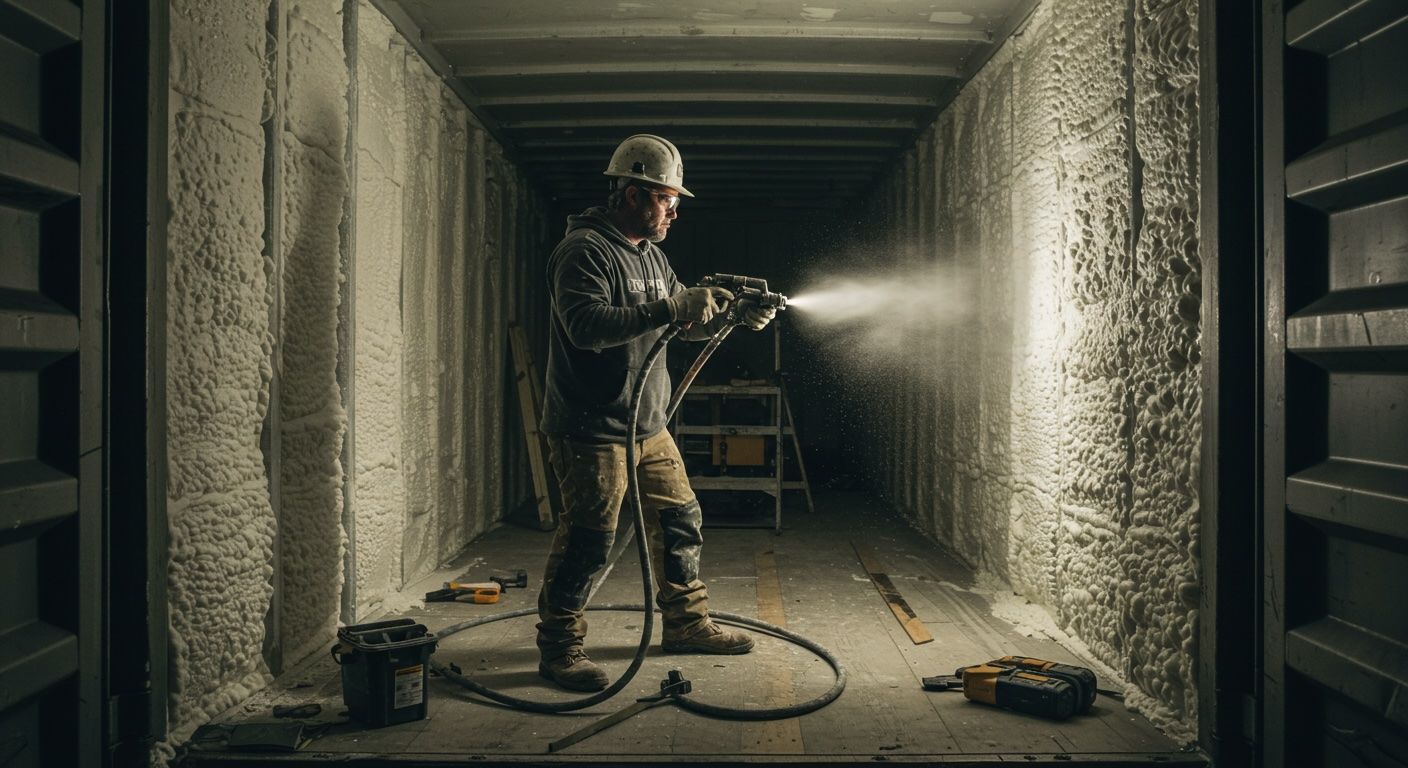SPRING SALE: Receive $100 Off Per Container
Can I Insulate a Shipping Container?
Corten steel containers used to transport goods globally for decades are also an incredible resource for land based personal use and storage.


You can insulate a shipping container and it’s highly recommended if you plan to use it for storage of valuable items, a living space, or any other purpose requiring temperature control. Shipping containers are made of steel, which conducts heat and cold efficiently, making insulation essential for comfort and energy efficiency. With a variety of insulation methods available—including spray foam, foam board insulation, or eco-friendly options—you can tailor the solution to your specific climate and needs. In this guide, we’ll explore the best options for insulating a shipping container and help you determine the right approach for your project.
Types of Insulation for Shipping Containers
Spray Foam Insulation
- Best for airtight sealing and moisture control
- Provides high R-value per inch
- Can be expensive but highly effective
Fiberglass or Rock Wool Insulation
- Cost-effective and commonly used
- Requires an interior frame for installation
- Can be prone to moisture retention if not properly sealed
Rigid Foam Board Insulation
- Lightweight and easy to install
- Resistant to moisture and mold
- Works well when combined with a vapor barrier
- Resource: InSoFast
Eco-Friendly Insulation (Sheep’s Wool, Cotton, or Cork)
- Sustainable and non-toxic
- Offers decent thermal performance
- May require additional moisture barriers
- Resource: Cork Insulation Guide

Key Factors to Consider
- Climate: In hot climates, reflective insulation can help reduce heat absorption. In colder regions, thicker insulation is needed.
- Ventilation: Prevent condensation buildup by allowing airflow.
- Budget: Costs vary depending on insulation type and installation method.
- Usage: If you plan to turn the container into a home or office, higher insulation levels may be necessary.
Optimizing Your Shipping Container with Insulation
Insulating a shipping container is completely feasible and can be customized for your specific needs. The right insulation method ensures durability, comfort, and protection against extreme temperatures. For expert insights, watch Tanner Bendheim of Bendheim Boards discuss insulating a container and transforming it into a functional workshop. You can also find insulation kits conveniently available on Amazon.
Frequently Asked Questions
Shipping containers can serve as a delightful standalone home, cozy personal office, She Shed or Man Cave. These containers are large, resilient intermodal containers that were once used to transport various goods. The 20-foot shipping containers provide around 160 square feet of livable space, while the 40-foot shipping containers offer approximately 320 square feet. For those seeking more spacious accommodations, multiple containers can be ingeniously combined to create a magnificent multilevel residence.
Containers are specifically designed to be resistant to wind and water, ensuring they remain durable and protected from harsh weather conditions like strong winds, heavy rainfall, and impacts from transportation vehicles. At Eveon Containers, we thoroughly inspect and guarantee that all containers we sell are wind and watertight, in accordance with our Container Quality Guarantee.
Make sure the items you’re packing are adequately sealed and aren’t damp. During the winter, unexpected moisture can cause things to warp or crack. During the spring thaw, humidity can attract pests and mold. Storing your items in vacuum-sealed bags, dry boxes, and with desiccants to ensure your items are safe no matter what.
Ventilation If condensation could be an issue, you need to install vents. You can install it on the end walls, container doors, and sidewalls. Best is to install 2 vents diagonally, so air can match the outside temperature.
Container Frozen to the Ground If the container sinks into the ground and the ground freezes, it is now frozen to the ground and can be nearly impossible to winch it out. If you plan to move your container during winter, ensure you have placed blocks beneath the corner posts.
Roof Damage Another way to prepare for winter is to check your container for damage, such as rust or pinholes. You don’t want a large amount of snow to concave the container ceiling and cause irreparable damage to your container or items inside. Push out any dents holding water and silicone or caulk pinholes where the sun is creeping in.
Rodents Rodents can sneak under your shipping container through the forklift pockets or mice/birds could nest in the corner castings. Although shipping containers are rodent-free and they won’t be able to gnaw their way into the container, rodents such as skunks, foxes, rats or bunnies can still make the underside of the container their home during winter.
**Maintain moving parts ** Keep an eye on the doors’ joints. By oiling and opening it now and then you can prevent the joint from rusting and fusing together.
Check that container is sealed Look for any cracks or gaps in the walls; anything that affects the humidity and airflow can lead to sudden environmental changes within your shipping container.

